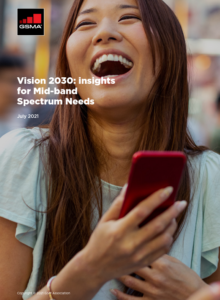For governments that want to continue to expand coverage and maximise the benefits from mobile connectivity in the Asia Pacific (APAC), spectrum roadmaps are critical. While 5G networks are well-established in advanced APAC markets such as Australia, Japan and South Korea, the pace of 5G development differs significantly across the region. Despite this, all countries have seen a massive growth in the number of subscribers and the capabilities of mobile networks.
Roughly every 10 years a new generation of mobile technology comes along, bringing fundamental improvements to the capabilities of mobile networks and changes to spectrum management approaches.
Here are key issues for governments and regulators in APAC to grapple with.
1. Spectrum roadmaps
A spectrum roadmap is essential to ensure there is enough spectrum to meet surging demand for mobile services in the long- and short-term. They help governments forecast future trends and manage their work. For mobile operators they mean increased certainty to invest based on the government’s future allocation, renewal plans and management of radio spectrum. This report looks at the current mobile services and spectrum status across the APAC region. It also sets out a roadmap to help governments and regulators enable 5G in the region.

Roadmaps for 5G spectrum: APAC

Country insights
2. Spectrum pricing
High spectrum prices continue to hinder the roll out of mobile services in cities and rural areas. However, for countries that take a different approach there are several benefits. For example, larger amounts of spectrum and lower spectrum prices are strongly linked to higher population coverage. The same is true for better download speeds and increased service adoption.

Effective spectrum pricing

Country insights
3. Access to mid-band spectrum
Mid-band spectrum is crucial for the successful rollout of 5G. It provides city-wide capacity for enhanced mobile broadband and FWA applications that will deliver access to services from online education to public administration, enable smart cities and drive digital industry. The GSMA has estimated that on average, a total of 2 GHz of mid-band spectrum will be required per market to support the growth of 5G by 2030. To realise the potential benefits, countries across APAC must fulfil mid-band needs in harmonised ranges including 3.5 GHz and 6 GHz to deliver economies of scale and lower broadband costs.

Mid-band spectrum needs

Socio-economic benefits of mid-band

6 GHz in the 5G era
4. Low-band spectrum
Low-band spectrum is the cornerstone of digital equality and a driver of broad and affordable connectivity, reducing the gap between urban and rural areas and delivering affordable connectivity. Without sufficient low-band spectrum, the digital divide is likely to widen, and those living in rural areas will be excluded from the latest digital technologies.

Socio-economic benefits of low bands

Low-band spectrum vision
5. 5G spectrum licensing
Licensing approaches will affect the impact of 5G spectrum on APAC. Robust licensing approaches which prioritise mobile broadband services above revenue maximisation are vital to delivering 5G for all businesses and consumers, creating digital inclusion and lowering the mobile usage gap. Optimal auction design and licence conditions will help 5G flourish and allow it to have the greatest impact on economic growth. Artificial spectrum scarcity must be avoided and setting 5G spectrum aside for verticals in priority bands can jeopardise the success of public 5G services, raise prices and waste spectrum. Sharing approaches like leasing are better options where verticals require spectrum access.

Effective spectrum licensing

Effective spectrum pricing


